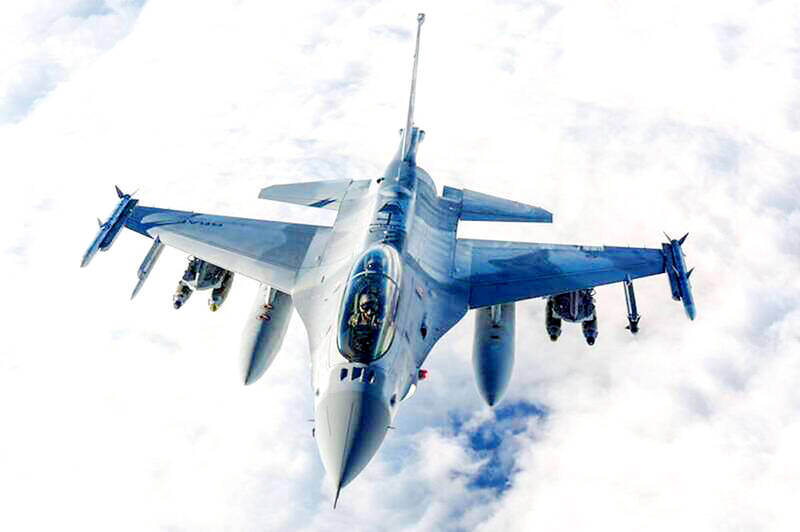The US is expected to fly 10 Lockheed Martin F-16C/D Block 70/72 jets to Taiwan over the coming months to fulfill a long-awaited order of 66 aircraft, a defense official said yesterday.
Word that the first batch of the jets would be delivered soon was welcome news to Taiwan, which has become concerned about delays in the delivery of US arms amid rising military tensions with China.
Speaking on condition of anonymity, the official said the initial tranche of the nation’s F-16s are rolling off assembly lines in the US and would be flown under their own power to Taiwan by way of Hawaii and Guam.

Photo: Screen grab from the US Air Force’s Web site
The aircraft would undergo 18 to 20 aerial refuelings during the transit, they said.
US pilots would fly the single-seat F-16Cs, with Taiwanese copilots in the double-seat F-16Ds to help familiarize them with their soon-to-be fielded fighters, the official said.
The jets would join the Taitung-based 7th Tactical Fighter Wing to serve alongside its F-16Vs, forming a unit with an authorized strength of 205 tactical aircraft, they said.
The 7th wing, composed entirely of modernized F-16s, would be the most powerful unit in the Taiwanese air force and shoulder the main responsibility of defending the nation in the air, they said.
The US in 1997 used the same method to deliver Taiwan’s first F-16s, they added.
For legal purposes, US personnel must retain control of the aircraft until Taiwan formally accepts them into service to complete the transfer of ownership, the official said.
The Ministry of National Defense obtained the F-16C/D Block 70/72 jets through the NT$247.2 billion (US$8.35 billion) New Combat Aircraft Procurement Program.
The F-16 has undergone numerous upgrades and improvements throughout its service life, which started in 1974, with Block 70/72 being the latest — and likely the last — version of the aircraft.
The Block 70/72 variant of the fighter is equipped with a more powerful radar, engine and avionics, features that Taiwan’s military believes are necessary to counter China’s most advanced tactical aircraft, some of which utilize stealth technology.
Air force Chief of Staff Lee Ching-jan (李慶然) on Wednesday last week told lawmakers that representatives of the Taiwanese military were working with Lockheed Martin Corp to hasten F-16 production.
Lockheed Martin increased the number of assembly line workers to boost manufacturing capability following requests by Taiwanese representatives, he added.
The military is optimistic that 10 or more of the new F-16s would arrive in Taiwan this year and the full order would be completed next year, he said.

TRAGEDY STRIKES TAIPEI: The suspect died after falling off a building after he threw smoke grenades into Taipei Main Station and went on a killing spree in Zhongshan A 27-year-old suspect allegedly threw smoke grenades in Taipei Main Station and then proceeded to Zhongshan MRT Station in a random killing spree that resulted in the death of the suspect and two other civilians, and seven injured, including one in critical condition, as of press time last night. The suspect, identified as a man surnamed Chang Wen (張文), allegedly began the attack at Taipei Main Station, the Taipei Fire Department said, adding that it received a report at 5:24pm that smoke grenades had been thrown in the station. One man in his 50s was rushed to hospital after a cardiac arrest

SAFETY FIRST: Double the number of police were deployed at the Taipei Marathon, while other cities released plans to bolster public event safety Authorities across Taiwan have stepped up security measures ahead of Christmas and New Year events, following a knife and smoke bomb attack in Taipei on Friday that left four people dead and 11 injured. In a bid to prevent potential copycat incidents, police deployments have been expanded for large gatherings, transport hubs, and other crowded public spaces, according to official statements from police and city authorities. Taipei Mayor Chiang Wan-an (蔣萬安) said the city has “comprehensively raised security readiness” in crowded areas, increased police deployments with armed officers, and intensified patrols during weekends and nighttime hours. For large-scale events, security checkpoints and explosives

PUBLIC SAFETY: The premier said that security would be tightened in transport hubs, while President Lai commended the public for their bravery The government is to deploy more police, including rapid response units, in crowded public areas to ensure a swift response to any threats, President William Lai (賴清德) said yesterday after a knife attack killed three people and injured 11 in Taipei the previous day. Lai made the remarks following a briefing by the National Police Agency on the progress of the investigation, saying that the attack underscored the importance of cooperation in public security between the central and local governments. The attack unfolded in the early evening on Friday around Taipei Main Station’s M7 exit and later near the Taipei MRT’s Zhongshan

A car bomb killed a senior Russian general in southern Moscow yesterday morning, the latest high-profile army figure to be blown up in a blast that came just hours after Russian and Ukrainian delegates held separate talks in Miami on a plan to end the war. Kyiv has not commented on the incident, but Russian investigators said they were probing whether the blast was “linked” to “Ukrainian special forces.” The attack was similar to other assassinations of generals and pro-war figures that have either been claimed, or are widely believed to have been orchestrated, by Ukraine. Russian Lieutenant General Fanil Sarvarov, 56, head